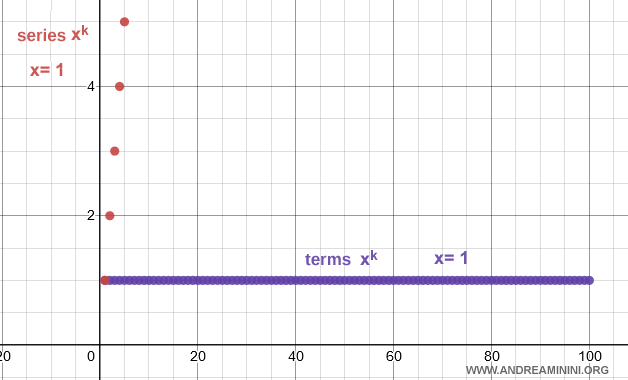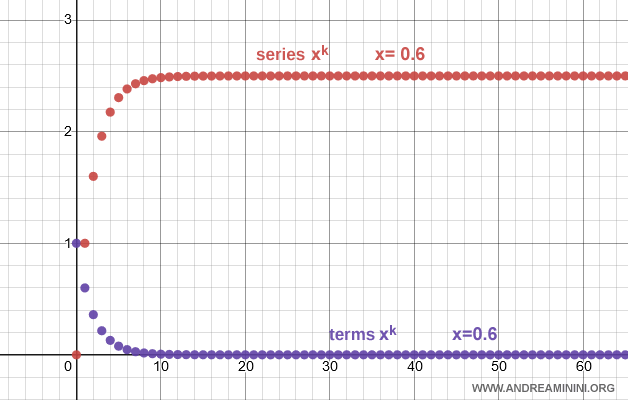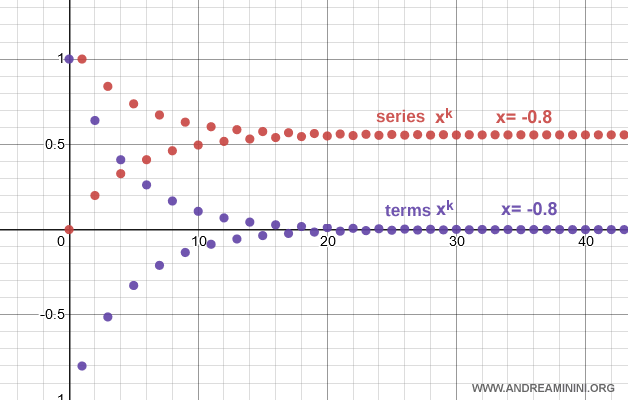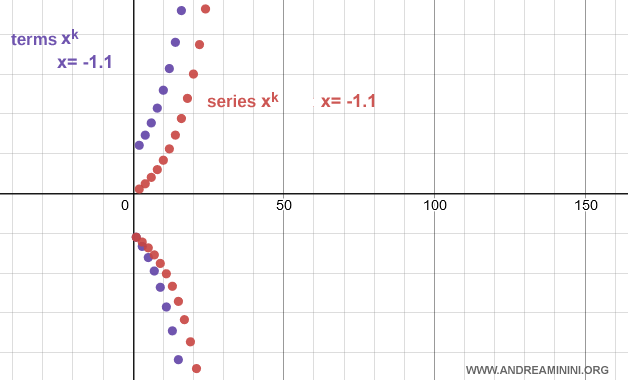Geometric Series
The geometric series is defined as: $$ \sum_{k=0}^{\infty} x^k = 1 + x + x^2 + \dots + x^k $$
The behavior of a geometric series depends on the value of $x$, referred to as the common ratio.
- x ≥ 1: the series diverges
- |x| < 1: the series converges
- x ≤ -1: the series is undefined or divergent
Determining convergence of a geometric series. When $-1 < x < 1$, the series converges to a finite value: $$ \sum_{k=0}^{\infty} x^k = \frac{1}{1 - x} $$
A practical example
1] Positive common ratio
If the ratio is positive ($x > 0$), the series is a non-negative series.
According to the theorem on non-negative series, such a series either converges to a finite limit or diverges to infinity.
We examine two cases: $x \ge 1$ and $0 < x < 1$.
Case: $x \ge 1$ - the series diverges
Since the terms are all non-negative, the series cannot be undefined. It must either converge or diverge.
To assess convergence, we evaluate the limit of the general term:
$$ \lim_{k \rightarrow \infty} x^k = +\infty \ne 0 $$
The limit does not approach zero, so the series cannot converge.
Therefore, for $x \ge 1$, the series is necessarily divergent:
$$ \lim_{n \rightarrow \infty} \sum_{k=0}^{n} x^k = \pm \infty $$
Example. If $x = 1.1$, the series diverges because the terms do not tend to zero.

Even when $x = 1$, the series diverges, since the terms converge to 1 rather than zero.

Case: $0 \le x < 1$ - the series converges
The series is still non-negative, so again it must either converge or diverge.
Evaluating the general term:
$$ \lim_{k \rightarrow \infty} x^k = 0 $$
This satisfies the necessary (but not sufficient) condition for convergence.
To determine the sum, we use the finite sum formula for geometric series:
$$ 1 + x + x^2 + \dots + x^n = \frac{1 - x^{n+1}}{1 - x} $$
Proof. Observing partial sums, we find: $$ \sum_{k=0}^{n} x^k = \frac{1 - x^{n+1}}{1 - x} $$ We prove this by induction. Base case ($n = 1$): $$ \sum_{k=0}^{1} x^k = 1 + x = \frac{1 - x^2}{1 - x} $$ Assuming the formula holds for $n$: $$ \sum_{k=0}^{n} x^k = \frac{1 - x^{n+1}}{1 - x} $$ Then: $$ \sum_{k=0}^{n+1} x^k = \left( \sum_{k=0}^{n} x^k \right) + x^{n+1} = \frac{1 - x^{n+1}}{1 - x} + x^{n+1} $$ $$ = \frac{1 - x^{n+2}}{1 - x} $$ Thus, the formula holds for all $n \in \mathbb{N}$.
We can now compute the limit:
$$ \lim_{n \rightarrow \infty} \sum_{k=0}^{n} x^k = \lim_{n \rightarrow \infty} \frac{1 - x^{n+1}}{1 - x} $$
Since $x^{n+1} \to 0$ as $n \to \infty$, we obtain:
$$ \frac{1}{1 - x} $$
Therefore, the series converges to $1 / (1 - x)$.
This is a convergent series.
Example. For $x = 0.6$, the series converges because $0.6^k \to 0$ as $k \to \infty$. The sum is: $$ \sum_{k=0}^{\infty} x^k = \frac{1}{1 - 0.6} = 2.5 $$ Below is the graph showing both the series and its terms.

2] Non-positive common ratio
If $x < 0$, we can no longer rely on the non-negative series theorem.
Thus, we cannot rule out the possibility that the series is undefined. A different method is required.
We still use the same identity:
$$ 1 + x + x^2 + \dots + x^n = \frac{1 - x^{n+1}}{1 - x} $$
We consider two separate cases:
Case: $-1 < x \le 0$ - the series converges
Evaluating the limit using the sum formula:
$$ \lim_{n \rightarrow \infty} \sum_{k=0}^{n} x^k = \lim_{n \rightarrow \infty} \frac{1 - x^{n+1}}{1 - x} $$
Since $|x| < 1$, $x^{n+1} \to 0$ as $n \to \infty$:
$$ \frac{1}{1 - x} $$
So the series converges to a finite value.
Example. If $x = -0.8$, the terms approach zero, and although the series oscillates, it converges to: $$ \sum_{k=0}^{\infty} x^k = \frac{1}{1 - (-0.8)} = 0.55 $$ Here is the corresponding graph.

Case: $x \le -1$ - the series is undefined
Using the same formula: $$ \sum_{k=0}^{n} x^k = \frac{1 - x^{n+1}}{1 - x} $$
When $x \le -1$, $x^{n+1}$ does not settle to a limit: it alternates and grows without bound depending on whether $n$ is even or odd.
Thus, the limit does not exist, and the series is: $$ \text{undefined} $$
Therefore, for $x \le -1$, the geometric series is considered a non-regular series.
Example. For $x = -1.1$, the series is undefined because the terms do not converge. Both the sequence and the series are oscillatory and unbounded.

The same behavior occurs when $x = -1$.
And so on.
